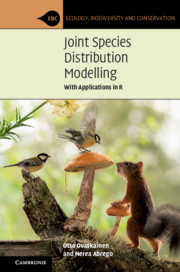Book contents
- Joint Species Distribution Modelling
- Ecology, Biodiversity and Conservation
- Joint Species Distribution Modelling
- Copyright page
- Contents
- Preface
- Acknowledgements
- Part I Introduction to Community Ecology
- Part II Building a Joint Species Distribution Model Step by Step
- 5 Single-Species Distribution Modelling
- 6 Joint Species Distribution Modelling
- 7 Joint Species Distribution Modelling
- 8 Bayesian Inference in HMSC
- 9 Evaluating Model Fit and Selecting among Multiple Models
- Part III Applications and Perspectives
- Epilogue
- References
- Index
7 - Joint Species Distribution Modelling
Biotic Interactions
from Part II - Building a Joint Species Distribution Model Step by Step
Published online by Cambridge University Press: 18 May 2020
- Joint Species Distribution Modelling
- Ecology, Biodiversity and Conservation
- Joint Species Distribution Modelling
- Copyright page
- Contents
- Preface
- Acknowledgements
- Part I Introduction to Community Ecology
- Part II Building a Joint Species Distribution Model Step by Step
- 5 Single-Species Distribution Modelling
- 6 Joint Species Distribution Modelling
- 7 Joint Species Distribution Modelling
- 8 Bayesian Inference in HMSC
- 9 Evaluating Model Fit and Selecting among Multiple Models
- Part III Applications and Perspectives
- Epilogue
- References
- Index
Summary
This chapter discusses how Hierarchical Modelling of Species Communities (HMSC) can be used to model residual associations among species, with the aim of capturing biotic interactions. The chapter starts with an overview of the different modelling strategies that can be used for estimating biotic interactions in species distribution models. It then builds the statistical approach, first discussing the relationship between occurrence probabilities and co-occurrence probabilities and then describing how latent variables can be used to compactly model co-occurrences in species-rich communities. After introducing the baseline model, the chapter extends it to hierarchical, spatial and temporal study designs, as well as to cases where the biotic interactions depend on the environmental conditions. The chapter then focuses on interpretation, recalling that residual associations can be caused by many processes other than biotic interactions, therefore great caution must be taken when interpreting associations as biotic interactions. The chapter also discusses when and how the estimated species associations can be used to make improved predictions. The chapter finishes with two case studies, the first of which is based on simulated data and the second on sequencing data on dead-wood inhabiting fungi.
Keywords
- Type
- Chapter
- Information
- Joint Species Distribution ModellingWith Applications in R, pp. 142 - 183Publisher: Cambridge University PressPrint publication year: 2020
- 1
- Cited by

